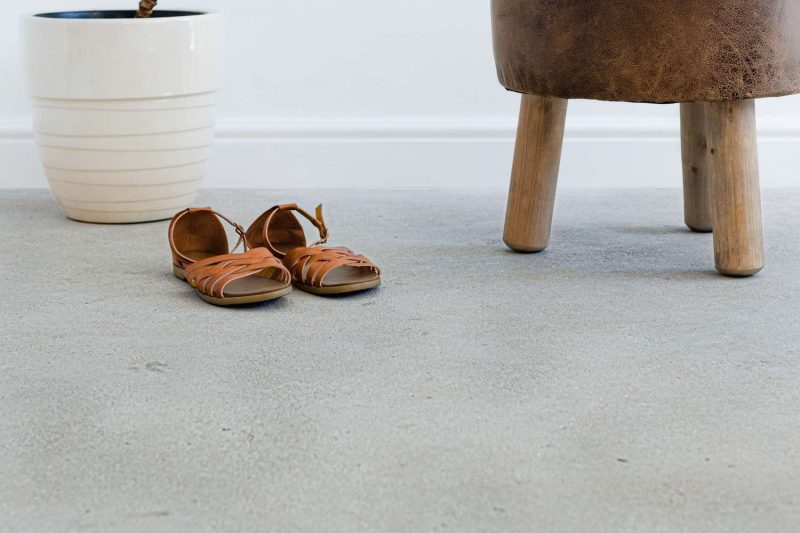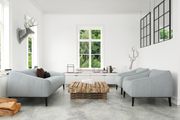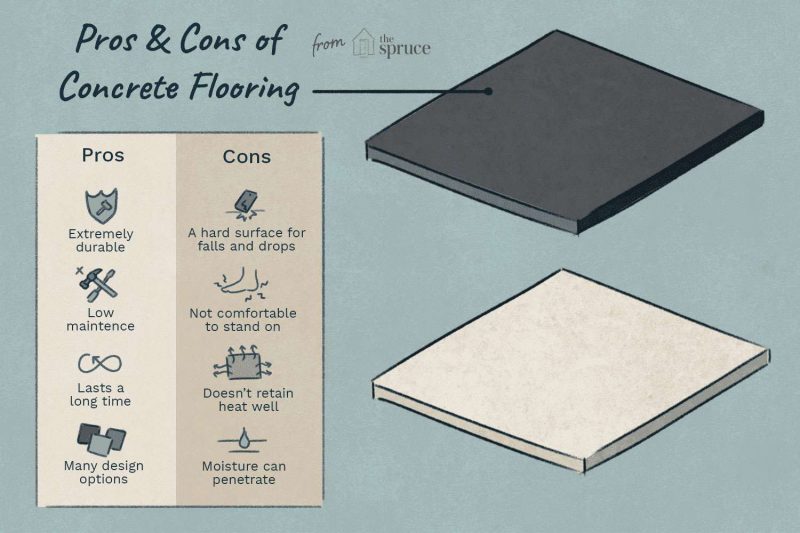Concrete floors are resilient, affordable, and simple to care for. With appropriate installation and upkeep, they can endure for many years. However, concrete isn’t limited to just garages and outdoor spaces. It can be stained, painted, polished, or stamped to create various textures. With a wide range of design possibilities, concrete flooring is suitable for finished basements, kitchens, and communal spaces.
Discover the reasons why concrete floors could be an excellent aesthetic choice for your residence.

9 Top Concrete Floor Finishes for a Luxurious Appearance

Contents
Cost of Concrete Flooring
The price of concrete flooring varies, starting at around $2 per square foot for standard options and reaching $30 or higher for premium, artistically designed surfaces.
- Fundamental design costs range from $2 to $6 per square foot. This type of concrete flooring involves the installation of the slab or overlay, followed by a simple polishing process and a single-color treatment, which can be achieved through staining or dyeing.
- Mid-tier design costs range from $7 to $14 per square foot. This pricing encompasses the process of pouring the slab or applying an overlay, followed by polishing and staining with various colors.
- Premium design: Ranging from $15 to $30 per square foot. The most intricate and costly concrete flooring options may feature the incorporation of geometric designs within the slab or overlay, along with a mix of colors and various texturing or stamping methods.

Upkeep and Restoration
Concrete floors are robust and long-lasting. While high heels, furniture legs, and pet claws won’t damage the concrete itself, they can leave scratches on the wax finish.
Concrete floors require sealing or waxing every one to three years, based on the amount of foot traffic. Additionally, it’s advisable to periodically clean the surface with a neutral cleaning solution when mopping.
Over time, concrete floors are prone to settling and developing cracks. This issue is particularly common when an old structural slab is transformed into a finished flooring surface for a home. If the floor sustains significant cracking, it can be repaired by sealing, patching, and polishing to bring back its luster.
Ease and Accessibility
Concrete floors offer minimal insulation and can feel quite chilly on winter mornings unless paired with a radiant heating system. Using carpets and area rugs can help mitigate the natural coldness of concrete.
When concrete surfaces are polished to a high shine or treated with a glossy sealant, they can become quite slick, particularly when they are wet. In areas like bathrooms, kitchens, or entryways, concrete floors can pose a slipping hazard when exposed to water, making it advisable to use mats for added safety.
Concrete Surface Treatments
Although a sleek, polished surface may be the ideal choice, there are numerous alternatives for concrete flooring finishes that offer a variety of colors and textures.
Color
- Acid staining involves applying gentle acids to concrete, resulting in a vibrant, variegated finish that resembles marble. Every floor created in this way is one-of-a-kind.
- Dyed: A dye is a coloring substance that produces a solid hue, resembling paint but with a greater level of opacity.
- Paint:
- Stenciled or airbrushed, concrete floors can act as expansive surfaces for a range of creative painting methods.
Texture
- Concrete can be polished using increasingly finer abrasive pads to achieve a glass-like surface.
- Stamping: When the concrete surface is still damp, it can be treated with brushes, stamped, or infused with glass beads or fine aggregates to create a textured, three-dimensional appearance.
- Geometric patterns: Premium concrete flooring is occasionally designed with geometric shapes, where each section is uniquely colored or textured to create an artistic impression.
Revamping Concrete Floors
Concrete floors that are already in place can frequently be revitalized by taking them out and polishing them to achieve a sleek surface.
- Take out the current flooring: Eliminate the carpet, vinyl, hardwood, or laminate flooring that is already installed.
- Repair fissures: Use sealant to mend cracks in the concrete floor.
- Refine the concrete surface by using abrasive pads, starting with coarser grits and gradually moving to finer ones.
- Options for treatment include applying a stain, dye, or paint to the concrete surface.
- Apply a concrete sealant to safeguard the surface.

Advantages and Disadvantages
- Inexpensive
- Durable
- Simple to upkeep
- Choices for design
- Extended longevity
- Hard
- Cold
- Vulnerable to humidity
- It is required to be closed off.
- Striking presence
Is a Concrete Floor Suitable for Your Needs?
Opting for a concrete floor can be a wise decision, especially if you already have a slab foundation and a home design that harmonizes with the aesthetic of polished concrete.
Numerous homeowners value the affordability of concrete flooring, particularly when taking into account its anticipated durability over time.
The compromise involves a firm and inherently chilly floor, making it advisable to extensively use carpets or to consider the installation of radiant heating.
FAQ
Which option is more budget-friendly: poured concrete or tile flooring?
If you’re not renovating an existing concrete surface, tile flooring tends to be less expensive than concrete flooring.
Is rebar necessary for concrete floors?
Concrete floors can be constructed without rebar, although incorporating it can enhance their durability. For concrete slabs subjected to significant weight, rebar is often necessary. In residential settings, concrete flooring in areas like basements and kitchens typically does not need rebar.
What is the usual lifespan of concrete flooring?
A well-sealed and well-maintained concrete floor has the potential to endure for many decades. It can withstand heavy foot traffic, making it suitable for commercial use. In the long term, this can lead to significant savings in both costs and labor compared to the frequent replacement of flooring.

